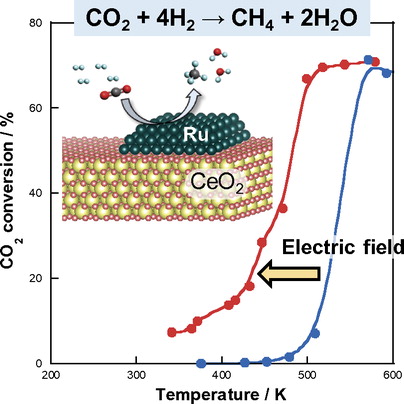Mar
17
Making Methane From CO2 With Electricity
March 17, 2020 | Leave a Comment
Waseda University scientists of Japan have developed a new method to convert carbon dioxide to methane with an electric field at low temperatures. Compared to previous methods, this new method can produce any amount of methane whenever necessary. Methane, the main component of natural gas can be used to generate heat and electricity, so this method could be used to recycle CO2 indefinitely.
The Waseda University scientists are led by Professor Yasushi Sekine who explained, “To recycle carbon dioxide into methane, an established industrial method involves the reaction of hydrogen and carbon dioxide using a ruthenium-based catalyst at temperatures of 300 to 400 degrees Celsius, but this method limited how much and when methane could be produced since it requires such high temperature. Additionally, operation at low temperatures was demonstrated to be favorable to improve carbon dioxide conversion and increase the amount of methane produced.”

Hydrogenation of CO2 to CH4 proceeds over Ru/CeO2 catalyst in an electric field even at low temperatures below 473 K, where conventional catalytic reaction without the electric field does not proceed. In the electric field, Ru/CeO2 catalyst exhibits high and stable activity without the hindrance of CO adsorbed on the Ru particle surface. Image Credit: Waseda University. Click image for the largest view.
The conversion of carbon dioxide to valuable chemicals such as methane has drawn great attention for use in supporting carbon capture and utilization. Its because methane can be used not only as fuel but also as a hydrogen carrier, transporting the gas to existing infrastructure. For instance, some plants in Germany have already been launched based on the Power to Gas concept, which allows energy from electricity to be stored and transported in the form of compressed gas.
In this newly-developed method reported in a paper published in Chemistry Letters, carbon dioxide can be converted into methane more efficiently and quickly in the 100 degrees Celsius range.
Sekine described the process, “This method involves a reaction of nanoparticles called cerium oxide with carbon dioxide in presence of ruthenium catalyst with an electric field. The results show that the catalyst exhibited high and stable catalytic activity for converting carbon dioxide to methane through hydrogenation with the electric field.”
With this novel method, methane could be produced from carbon dioxide collected from the atmosphere, or more likely, enabling an unlimited amount of methane production by recycling carbon dioxide from the combustion effluent released from factories into valuable energy resources.
For now the process would have to run at exceptionally low cost as fossil fuels prices, at the time of posting, are crashing down. But as we all know, the market will turn up someday. The electricity is going to have to be cheap. But it is reassuring that there are answers to a fueled future coming and looking quite practical.

